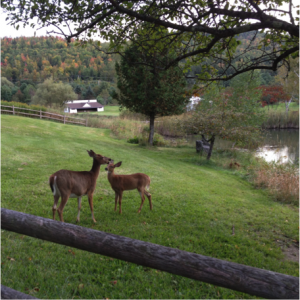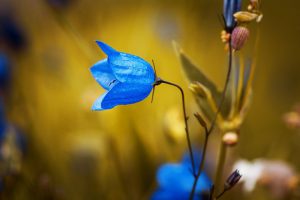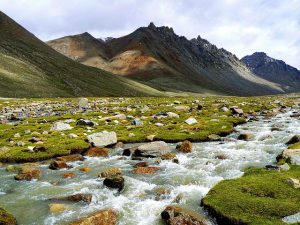Monday
Featured StoriesWorking with Perception 1
Part One of an interview with Shastri Donna Williams about embodying Earth energy
 Mike de Give, KCL: You’ve been working on developing future programs around embodying Earth energy. Can you tell me about your interest in this topic?
Mike de Give, KCL: You’ve been working on developing future programs around embodying Earth energy. Can you tell me about your interest in this topic?
Donna Williams: There are a couple of streams here. One is the book The Nature Fix, which outlines all of the therapeutic uses that different cultures have used in the natural world to take care of high stress, high blood pressure, cancer, a lot of auto-immune diseases — there’s a lot of research that’s cited in this book.
But the other stream that came together for me were the teachings that Chögyam Trungpa gave on working with perception. I’ve kind of done a re-dive into abhidharma and looking at the skandhas. He said that in a lot of cultures, particularly in our Judeo-Christian culture here in the U.S., we view the senses as something scary or something to be avoided, something that’s going to lead us down some erroneous path. But in the Tibetan Buddhist Tradition, the senses are actually a gateway to experiencing our world directly and experiencing the full color and depth of our world.
What I see is that when we can unplug ourselves from our busy conceptual mind, we can experience a lot of relaxation and joy from connecting to the world from our senses.
KCL: When you said that we fear the senses, it seemed to me that we use our senses more and more to plug into artificial things. We’ll watch movies for hours on end on Netflix, or we’ll eat stuff that’s just processed to here and back, stuff that’s sort of gross and bad for us. What does that say to you?
 Donna: Well, what it says to me is that we have to re-tune our senses. What I try to do in this retreat is do sensory awareness exercises that really highlight the senses: “what is the sense of smell?” “how do I experience taste?” “how do I experience touch?” So, using what I call the natural world, like the landscape that we’re in, which can happen anywhere, we’re actually working with a direct connection to our world, as opposed to our–as you said–overprocessed senses.
Donna: Well, what it says to me is that we have to re-tune our senses. What I try to do in this retreat is do sensory awareness exercises that really highlight the senses: “what is the sense of smell?” “how do I experience taste?” “how do I experience touch?” So, using what I call the natural world, like the landscape that we’re in, which can happen anywhere, we’re actually working with a direct connection to our world, as opposed to our–as you said–overprocessed senses.
If we look at the teachings that are in Chögyam Trungpa’s book Shambhala: Sacred Path of the Warrior, in one of the chapters he describes working with our perceptions directly. So he says that we’ve never experienced the red of red, or the blue of blue, or the feeling of water. We can take a deep dive into our senses. That’s how I think of it. We can actually be immersed. It’s a work-around of our conceptual mind. That by just merely looking at a flower, we can actually be with the flower. This artificial idea, that here I am over here and there’s the flower over there, is unnecessary.
KCL: Do I have to know something about the skandhas to understand this?
Donna: No!
KCL: That’s good, because I don’t really know what a skandha is yet, even though I’ve read about them.
 Donna: Well, it’s interesting because one thing that the Tibetan Buddhist lineages have done is organize how our minds work. So meditation is a study of our mind, how it works, and what we can do with it. This [program] is about something thing we can do with our minds, to some extent. Usually we talk about taming the mind, or having some sort of flexibility. These are all terms that we use when we talk about the advantages of mindfulness practice. But in this sense we’re looking at something — not different — but sort of an elaboration of what our minds are actually capable of, or what we are capable of.
Donna: Well, it’s interesting because one thing that the Tibetan Buddhist lineages have done is organize how our minds work. So meditation is a study of our mind, how it works, and what we can do with it. This [program] is about something thing we can do with our minds, to some extent. Usually we talk about taming the mind, or having some sort of flexibility. These are all terms that we use when we talk about the advantages of mindfulness practice. But in this sense we’re looking at something — not different — but sort of an elaboration of what our minds are actually capable of, or what we are capable of.
Part of our birthright is that we have eyes and ears and tongues and noses and all of these sensory apparatus, but we spend a lot of time cutting it down or controlling it. Like, we’ll go for a walk in the woods but we’ll have our earbuds in because we want to hear the sounds that we want to hear. So this is kind of like unplugging from that, and seeing what can happen. Like, ‘what’s the effect on my whole being of immersing myself in the senses?’ And we find that we experience a lot of relaxation, a feeling of harmony, that we slow down and develop a real appreciation for where we are.
Editor’s note: Part two of this conversation will appear on Wednesday, June 20th.
















